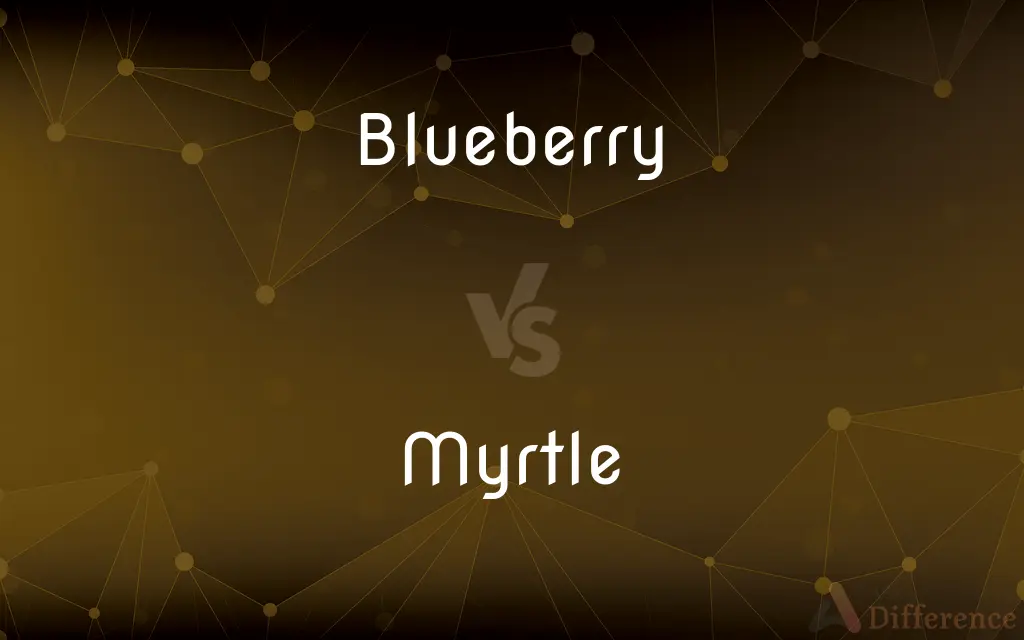Blueberry vs. Myrtle — What's the Difference?
By Urooj Arif & Fiza Rafique — Updated on March 26, 2024
Blueberry plants are fruit-bearing shrubs known for their edible, blue-purple berries, e.g., "He picked blueberries." Myrtle is an evergreen shrub with aromatic leaves and white flowers, not primarily for its fruit, e.g., "The myrtle bloomed beautifully".

Difference Between Blueberry and Myrtle
Table of Contents
ADVERTISEMENT
Key Differences
Blueberries belong to the genus Vaccinium and are valued for their sweet, nutritious berries often consumed fresh, in jams, or baked goods. These plants are characterized by their bell-shaped flowers and blue to purple berries, thriving in acidic soil. On the other hand, myrtle, belonging to the genus Myrtus, is celebrated for its aromatic, glossy leaves and star-shaped white flowers. It's often used in landscaping and for its essential oils, rather than its fruit.
While blueberry plants are predominantly grown for their fruit in agricultural settings, myrtles are cultivated for ornamental purposes, including their attractive foliage, flowers, and the pleasant fragrance they emit. Blueberries are a significant source of vitamins, antioxidants, and dietary fiber, contributing to their popularity in diets, whereas myrtle leaves and berries are sometimes used in traditional medicine and culinary applications, albeit to a lesser extent.
In terms of care, blueberries require well-drained, acidic soil and benefit from specific pruning to maximize fruit production. Myrtle plants, however, are more adaptable to a range of soil types and conditions but still prefer sunny locations to flourish and produce dense foliage.
The blueberry’s growing season and fruit-bearing habits also distinguish it from the myrtle. Blueberries produce fruit on the previous year's growth and require cold winters for dormancy and fruit production. Conversely, myrtle blooms in late summer, with its fruits often persisting on the plant through winter, depending on the climate.
Comparison Chart
Genus
Vaccinium
Myrtus
ADVERTISEMENT
Primary Use
Fruit production
Ornamental, aromatic foliage and flowers
Soil Preference
Acidic, well-drained
Adaptable, prefers well-drained
Climate
Cold winters for dormancy, fruit production
Warm, tolerates a range of conditions
Edible Parts
Berries
Leaves and berries used in traditional medicine
Flowering Time
Spring
Late summer
Fruit Season
Summer
Late summer to fall, fruits persist through winter
Nutritional Value
High in vitamins, antioxidants, dietary fiber
Limited culinary use, used in traditional medicine
Compare with Definitions
Blueberry
Nutritious berries.
Blueberries are high in antioxidants.
Myrtle
Aromatic evergreen.
The myrtle’s fragrance filled the garden.
Blueberry
Grown for fruit.
The farm cultivates blueberries for sale.
Myrtle
Star-shaped flowers.
The myrtle bloomed with white flowers.
Blueberry
Popular in diets.
She added blueberries to her smoothie.
Myrtle
Ornamental use.
Myrtles are popular in landscape design.
Blueberry
Fruit-bearing shrub.
Blueberry bushes require acidic soil.
Myrtle
Adaptable plant.
Myrtle can grow in various soil conditions.
Blueberry
Requires cold winters.
Blueberries need cold weather to produce fruit.
Myrtle
Traditional medicine.
Myrtle leaves were used in ancient remedies.
Blueberry
Blueberries are a widely distributed and widespread group of perennial flowering plants with blue or purple berries. They are classified in the section Cyanococcus within the genus Vaccinium.
Myrtle
Any of several evergreen shrubs or trees of the genus Myrtus, especially M. communis, an aromatic shrub native to the Mediterranean region, having white flowers and blue-black berries and widely cultivated as a hedge plant.
Blueberry
A small sweet blue-black edible berry which grows in clusters on North American shrubs related to the bilberry.
Myrtle
Any of several other evergreen shrubs or trees, such as the wax myrtle.
Blueberry
One of the dwarf shrubs that produces blueberries, some kinds being cultivated for their fruit or as ornamentals.
Myrtle
The periwinkle Vinca minor.
Blueberry
Any of various plants of the genus Vaccinium, having white to reddish, urn-shaped or tubular flowers and edible blue to blue-black berries, especially the highbush blueberry and the lowbush blueberry.
Myrtle
An evergreen shrub or small tree of the genus Myrtus, native to southern Europe and north Africa.
Blueberry
The fruit of any of these plants.
Myrtle
Cyrilla spp.
Blueberry
A usually blue-gray spherule that is found in soil and sedimentary rock and is rich in hematite, produced by the weathering of rock or by precipitation from rock by moving groundwater.
Myrtle
A species of the genus Myrtus, especially Myrtus communis. The common myrtle has a shrubby, upright stem, eight or ten feet high. Its branches form a close, full head, thickly covered with ovate or lanceolate evergreen leaves. It has solitary axillary white or rosy flowers, followed by black several-seeded berries. The ancients considered it sacred to Venus. The flowers, leaves, and berries are used variously in perfumery and as a condiment, and the beautifully mottled wood is used in turning.
Blueberry
(countable) An edible round berry, belonging to the cowberry group (Vaccinium sect. Cyanococcus), with flared crowns at the end, that turns blue on ripening.
Myrtle
Widely cultivated as a groundcover for its dark green shiny leaves and usually blue-violet flowers
Blueberry
(countable) The shrub of the above-mentioned berry.
Myrtle
Any evergreen shrub or tree of the genus Myrtus
Blueberry
A dark blue colour.
Blueberry
Of a dark blue colour.
Blueberry
To gather or forage for blueberries.
Blueberry
The berry of several species of Vaccinium, an ericaceous genus, differing from the American huckleberries in containing numerous minute seeds instead of ten nutlets. The commonest species are Vaccinium Pennsylvanicum and Vaccinium vacillans. Vaccinium corymbosum is the tall blueberry.
Blueberry
Any of numerous shrubs of the genus Vaccinium bearing blueberries
Blueberry
Sweet edible dark-blue berries of either low-growing or high-growing blueberry plants
Common Curiosities
Can you eat myrtle berries?
Myrtle berries are edible but are not commonly consumed as they are more valued for their ornamental and aromatic properties.
Are blueberries and myrtle used in traditional medicine?
Blueberries are known for their nutritional benefits, while myrtle has been used in traditional remedies, particularly its leaves and berries.
What are the main uses of blueberries and myrtle?
Blueberries are primarily grown for their edible fruit, while myrtle is used for ornamental purposes and its aromatic qualities.
What makes blueberries popular in diets?
Their high content of vitamins, antioxidants, and dietary fiber makes them a nutritious addition to various diets.
What are the maintenance requirements for blueberries compared to myrtle?
Blueberries require specific soil pH and pruning for fruit production, while myrtle needs less specific care but does best in sunny spots.
How do the flowers of blueberries and myrtle differ?
Blueberry flowers are bell-shaped, often white to pink, while myrtle flowers are star-shaped and white.
How do blueberries and myrtle differ in their growing conditions?
Blueberries thrive in acidic, well-drained soil with cold winters, whereas myrtle is more adaptable but prefers sunny locations.
How do blueberries and myrtle contribute to biodiversity?
Both plants provide habitat and food for wildlife, but blueberries specifically offer nutritious berries for birds and insects.
Is there a symbolic meaning associated with myrtle?
Myrtle has been associated with love and marriage in various cultures, symbolizing fertility and peace.
Can myrtle survive in cold climates?
Myrtle prefers warmer climates but can tolerate some cold if properly protected.
How long does it take for a blueberry plant to bear fruit?
Blueberry plants typically begin to bear fruit 2 to 3 years after planting.
Can both blueberries and myrtle be used in cooking?
Blueberries are widely used in culinary applications, while myrtle leaves and berries are used occasionally in traditional cooking and medicine.
What is the significance of soil pH for growing blueberries?
Soil pH affects nutrient availability for blueberries; acidic soil is essential for their growth and fruit production.
Do blueberries or myrtle require more water?
Both plants prefer well-drained soil, but blueberries may require more consistent moisture during the fruiting season.
Are there different varieties of myrtle and blueberries?
Yes, there are numerous varieties of both, adapted to different climates and offering various sizes, flavors, and ornamental qualities.
Share Your Discovery

Previous Comparison
Donut vs. Sinker
Next Comparison
Famous vs. SuperstarAuthor Spotlight
Written by
Urooj ArifUrooj is a skilled content writer at Ask Difference, known for her exceptional ability to simplify complex topics into engaging and informative content. With a passion for research and a flair for clear, concise writing, she consistently delivers articles that resonate with our diverse audience.
Co-written by
Fiza RafiqueFiza Rafique is a skilled content writer at AskDifference.com, where she meticulously refines and enhances written pieces. Drawing from her vast editorial expertise, Fiza ensures clarity, accuracy, and precision in every article. Passionate about language, she continually seeks to elevate the quality of content for readers worldwide.
















































